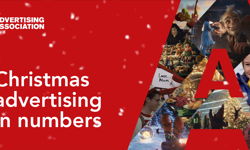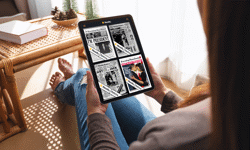Bob Patchen isn’t exactly a name to conjure with in the newspaper industry. Indeed it is unlikely that many, certainly in the British newspaper industry, will have even heard of him.
Project Apollo
That could be about to change. Patchen, chief research officer of Arbitron, the US media measurement and research company is at work on Project Apollo - a collaboration with fellow market research group Nielsen and seven major global advertisers, including some of the biggest such as Unilever and Procter & Gamble.
In research terms, it really is a reach for the moon. The aim is to tie in all media use electronically – new and old - with actual data on consumer purchases.
In the jargon - "a single-source, multi-media and purchase measurement system."
What has that got to do with newspapers? As it happens, quite a lot.
Arbitron already has a Portable People Meter (PPM) which produces real data on broadcast viewing and listening. Now the plan is to tie this in with RFID - radio frequency identification. RFID is a tiny wafer-thin radio circuit that emits a signal which can be picked up by the people meters and fed back to headquarters.
The radio circuits are so small, and potentially so cheap, that they can be attached to the pages of newspapers and magazines.
"It’s like an electronic bar code and we think it’s a big part of the future. We can measure time spent with the newspaper," Patchen told InCirculation.
It should equally be possible to incorporate time spent browsing through newspaper content online.
The push will come partly from the retail sector where Wal-Mart, the world’s largest supermarket group, has instructed its suppliers that all their products should be RFID tagged within three years.
"The whole point is that you can tie everything together through this passive portable measurement system - radio, television, newspapers, magazines, in-store media and retail purchases," says Patchen who outlined his ideas at the recent inaugural Venice Festival of Media.
He regards Project Apollo as "execution on a really grand scale" of the sort of ideas developed in the IPA TouchPoints programme. Indeed, Patchen has already had preliminary discussions about the project in the UK.
Back on earth and the British newspaper industry, gradual progress is being made by both the Audit Bureau of Circulations (ABC) and the National Readership Survey (NRS) in pursuit of "the Holy Grail" – finding a way of integrating sales of paper copies and the impact of online readership.
At stake, as circulations continue their gradual decline, with the notable current exception of the Financial Times, is nothing less than the extent to which newspapers are financially compensated for their online intellectual property.
Progress at the ABC
At the ABC, they are treading carefully because not all national newspaper members have embraced the internet at the same rate and with the same enthusiasm. Some, such as the Guardian, Daily Telegraph and the Times, are well advanced and have been putting increased resources into their online presence.
Others have clearly lagged behind and are not exactly keen on a universal published audit of online numbers – because those numbers would be embarrassingly small for them at the moment.
Chris Boyd, the ABC chief executive who spent his working life in the magazine industry with IPC, believes that the situation is changing and now everyone gets the importance of the internet.
"In my view, 2006 was the defining year. Until then most were saying, ‘yeah yeah’ and putting a few million in but they weren’t taking it very seriously. In 2006, we said this is here. This is now established. This is mainstream," argues Boyd. The ABC chief executive is also involved with the World Association of Newspapers which is looking at the same conundrum – how do you combine print and online.
"This is a global thing and there is no-one who has come up with a solution yet," says Boyd.
In fact, it is still not universally agreed what the solution should be, never mind how to achieve it.
"Basically, what we are saying, and what the media buyers are saying to us, is that we don’t want things added together because it’s apples and pears and apples and elephants. There is absolutely no point in adding together something that is meaningless," says the ABC chief executive.
Naturally, publishers tend to want to add everything they possibly can together to make the biggest number possible. And, if the number should turn out to be larger than that of their immediate rivals, then that would be so much better.
One approach might be to produce a research paper detailing all the interactions a consumer has with a newspaper or magazine brand.
Another, which Boyd is quite keen on, is trying to come up with the print and online equivalent of the "commercial impact" on television.
"The next stage is – and I haven’t got an answer yet - is there a measure like an impact which advertisers use when they talk about commercial impacts? We then come up with an impact which can be audited. We are not there yet. The industry is not there yet," admits Boyd.
In the meantime, until some over-arching solutions are found, what the ABC has done for those national newspaper that want it, is to produce an ABC Group Product Report.
The report, produced by ABC and ABC Electronic, sets out certified numbers, say for the Times or the Guardian.
Full details are set out on every aspect of the paper’s circulation, covering everything from average net circulation to average circulation per issue and including paid subscription rates and multiple copy sales. But the report also details a daily record of both unique users and page impressions for the online versions of the title.
The certified numbers are set out side by side for media buyers to make their own judgment but are emphatically not added together.
The group product reports are becoming more popular and a number of magazines are already talking to the ABC about extending the concept to their industry.
"Potentially there must be something else, but what it is, we haven’t got there yet. At the moment there isn’t one definitive answer. Advertisers and agencies say we don’t want one figure because they are still buying print and they are still buying online," says Chris Boyd.
The NRS approach
Over at the NRS, they too are trying to produce solutions that address the problems thrown up by the internet.
Its latest initiative involves putting together an experimental programme to deliver "a measure of reach" of individual websites.
The NRS already asks its 36,000 strong panels over the course of a year whether or not they use the web. Now NRS researchers are going one stage further by asking panellists whether they have used a particular website in the past 12 months.
A self-completion questionnaire is now being drawn up and should be in use in the field by June and the first data should be available by the end of the year.
"We are not going to ask them (the panel) how often they have visited the websites because we don’t think that recall is a sensible way of doing that," says Roger Pratt, managing director of NRS.
Instead, the organisation plans to identify the top 50 or so websites and find how many the panellists have used.
It is seen very much as an interim stage and there is always the danger of something unexpected being thrown up by the process. After all, the present NRS figures are not exactly uncontroversial because of the dreaded problem of often unexplained "sample variation".
However, once the initial web questionnaire has been successfully introduced, the aim is to get the survey itself onto the web and devise a method of using the web to gather the data.
Pratt fears it will be a complicated manoeuvre, partly because there is such difference between individual websites.
What the NRS executive believes will be possible – in contrast to the ABC numbers - is to add the two numbers together as a measure of reach.
"This will be hugely beneficial. We will be able to say you reached X people in print and Y people in the web site and the total is…," says Pratt.
"We will be able to calculate a net reach and that is streets ahead of where we are at the moment," he adds.
A lot of data is already available on such things as web page impressions and unique users but much less on what type of people they are in terms of gender or age.
"But it does raise a much bigger question in my mind which I don’t actually understand at this point and I don’t think anyone else does either; what the relationship between the printed product and the website actually is and how to use it for advertising purposes," says Pratt.
Everywhere you look there are complexities. Most people in the industry know, for example, what the average issue readership of a newspaper is. But with the web there is no "issue"; instead it is something that is constantly changing and constantly being updated. Yet another challenge is to try to come up with an agreed metric for a website.
"We are going to let the market decide what the right basis of measurement is and we don’t want to be prescriptive," says the NRS managing director.
"We are trying to be as flexible as we can but we certainly are not over- claiming about what it is we are about to deliver, although we think it is going to be a huge improvement on what is available at the moment," argues Roger Pratt.
Or at least until RFID systems or other technological advances become commonplace in five years or so.
FEATURE
Apples and Pears
Ever since the internet was first identified as one of the contributory factors in newspaper circulation decline, publishers and advertisers have been obsessing over measurement issues; in particular the search for a single measure of a newspaper’s on and offline reach. The subject was discussed at the recent Venice Festival of Media. Ray Snoddy was there.










